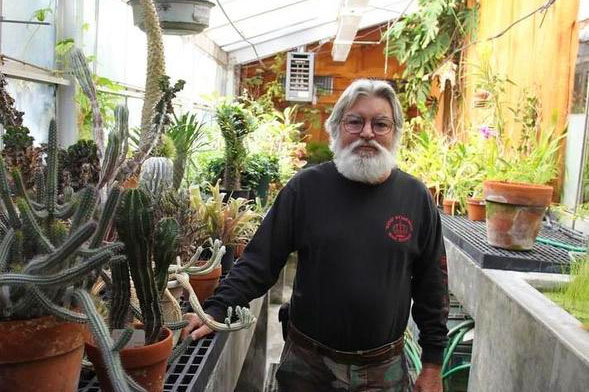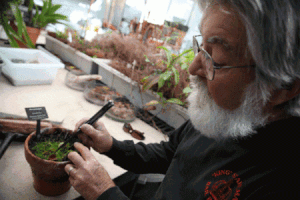A Green Oasis on Campus
SDSUs greenhouse contains a marvelous variety of plants that are beautiful, amazing and occasionally downright fetid.

The Curious Aztec takes you behind the scenes of scientific investigation and discovery taking place at San Diego State University.
The greenery around campus at San Diego State hews closely to what you’d expect from our region’s coastal semi-arid climate: a plethora of palms, birds-of-paradise and succulents. But tucked into a courtyard between Life Sciences North and South, you’ll find a much more exotic assortment of flora. SDSU’s greenhouse contains more than 400 species of plants from around the world, including peculiar and rare specimens that require delicate, expert care.
The green thumb behind all this lushness is Bob Mangan. His business card lists his position as “Instructional Support Tech,” but the greenhouse’s website has a much more apt description: protector of plants. Mangan, with his army fatigue pants and full white beard, earned his bachelor’s degree in botany from SDSU in the 1970s and really never left—the decade or the campus, take your pick.

Visiting hours for the greenhouse are 9 – 11 a.m., Monday through Friday, and if you can spare a few minutes, I highly recommend you ask the charismatic and colorful Mangan for a quick tour.
“Feed me, Seymour!”
Mangan shares an office with the greenhouse’s bog pond room, home to several kinds of carnivorous plants. You’ve probably heard of the Venus fly trap. He’s got a few of them. On their modified mouth-leaves are three tiny hair-like growths that act as triggers. If you (or a tasty fruit fly) touches just one of these triggers, nothing happens.
“But touch two at the same time and faster than God gets the news, that thing can move,” Mangan said, triggering the trap with his pocketknife.
Besides the fly trap, there are other fearsome greens. Mangan pointed to some mossy-looking growth with hundreds of pinhead-sized flowers protruding skyward.
“There’s some stuff here that kind of looks like pond slime that is actually insectivorous,” he said. A species of Utricularia, the plant feeds on mosquito larvae and other tiny bugs that get sucked into its vacuum-powered trapdoors.
Then there are the pendulous pitcher plants, whose enormous hollow bulbs invite insects in for a drink, then never let them leave. Some can grow big enough to drown rats, Mangan explained.
In an adjacent room, there’s the cactus-like Euphorbia lactea, native to tropical East Asia and India. It looks relatively harmless, but its milky latex secretions can cause temporary blindness—as Mangan once found out the hard way when he wiped his eyes after handling the plant.
Incredible, edible
Lest you think everything in the greenhouse is trying to eat, kill or otherwise incapacitate you, let Mangan direct your attention to his vanilla plant, the orchid from which vanilla flavoring is derived from. It’s also a real bear to grow.
“I’ve been here 36, maybe 37 years, I can’t remember, and I’ve had his vanilla since I started,” Mangan said. “It’s only flowered once.”

More productive is the greenhouse’s Theobroma cacao, or chocolate tree. Thick pods grow on the tree containing the seeds that eventually become chocolate once they’ve been allowed to rot and ferment inside banana leaves. Mangan usually is able to grow enough of the pods to allow students in the Biology 460 Economic Botany class to produce their own chocolate.

Other highlights include:
- A Traveller’s Palm—a misnomer, as it’s not a true palm, but a relative of the bird-of-paradise—with fanning fronds that always grow along a north-south axis.
- A massive fig tree that over the years broke through its terra cotta pot and grew through the roof. (“If I had been smart when I was younger, I would have killed that thing,” Mangan said.)
- Dracunculus vulgaris, otherwise known as the “Stink Lily.” It doesn’t look like much at the moment, but when it grows and blooms, it will produce a gigantic purplish flower that emits an intense, fragrant bouquet reminiscent of rotting meat. The smell attracts flies, which act as pollinators for the plant.
So maybe call ahead before you visit to make sure it’s not Stink Lily season.



